Spinel is a mineral that belongs to the group of oxides and forms in various colors, making it a popular gemstone. Its chemical composition is magnesium aluminum oxide (MgAl2O4). Spinel crystals have an octahedral crystal structure and are often found as octahedral, rounded grains or as single crystals.
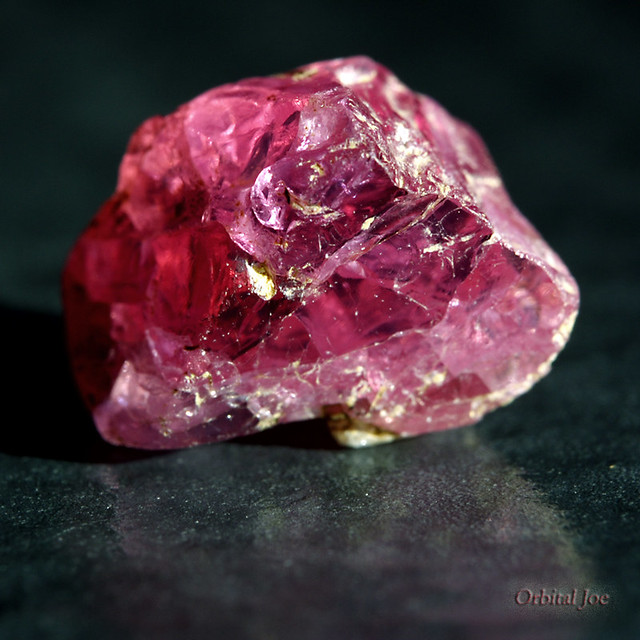
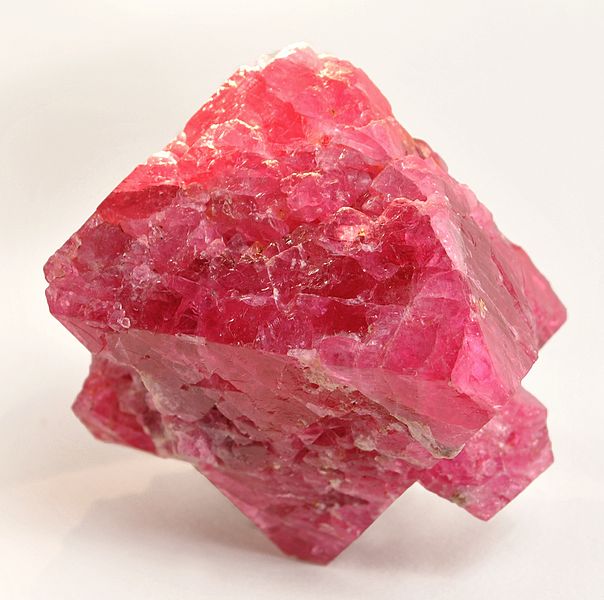
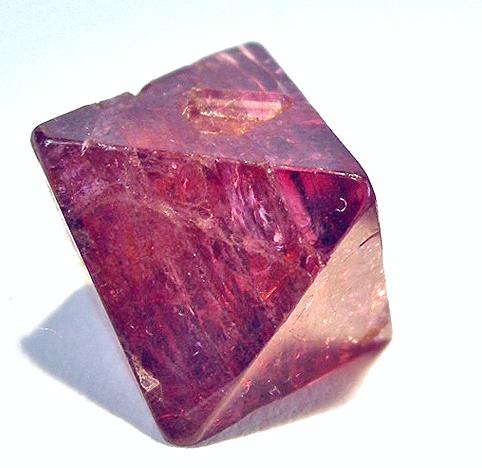
Name: Perhaps from the Latin spinella, for little thorn, in allusion to the spine-shaped octahedral crystals.
Association: Forsterite, chondrodite, scapolite, phlogopite, corundum, sillimanite, andalusite.
Mineral Group: Spinel group.
Polymorphism & Series: Forms three series, with magnesiochromite, with gahnite, and with hercynite.
One of the distinctive features of spinel is its wide range of colors, which include red, pink, orange, blue, purple, and even black. This color variation is due to trace elements present in the crystal lattice. The most famous color for spinel is red, which often resembles the red hues of ruby. In fact, historical confusion between red spinel and ruby has led to some spinels being misidentified as rubies in the past.
Historical Significance:
Spinel has a rich historical significance, closely tied to its resemblance to other gemstones, most notably ruby. Here are a few notable points in its history:
- Historical Confusion with Ruby: Some of the most famous “rubies” in royal collections, such as the “Black Prince’s Ruby” in the British Imperial State Crown and the “Timur Ruby” in the British Crown Jewels, are actually spinels. Due to its similar appearance to ruby, spinel has often been mistaken for the more valuable gem.
- Ancient Trade and Use: Spinel has been used in jewelry and decorative arts for centuries. It was highly valued in ancient civilizations like the Roman Empire and was traded along the Silk Road.
- Famous Gemstones: The “Black Prince’s Ruby,” which adorns the Imperial State Crown of England, is a large red spinel. It is rumored to have been in the possession of various historical figures, including Edward, the Black Prince.
- Historical Literature and Records: Historical accounts, including writings from Pliny the Elder, mention gemstones that were likely spinels. These writings offer insights into the perceived beauty and value of spinel in ancient times.
- Significance in Eastern Culture: Spinels have also held significance in Eastern cultures. For instance, some spinels from Sri Lanka were considered to be among the most treasured gems in ancient Sinhalese culture.
- Gemstone Lore and Beliefs: Spinels were attributed with various mystical and healing properties throughout history. They were believed to protect the wearer from harm, boost energy, and bring wisdom.
While spinel might have once lived in the shadow of other gemstones due to its mistaken identity, it is now recognized and appreciated for its unique beauty and historical significance. In recent times, spinel has gained renewed attention and popularity as a desirable gemstone in its own right, especially for its range of colors and its potential use in jewelry.
Chemical Composition

The chemical composition of spinel is magnesium aluminum oxide (MgAl2O4). It consists of equal proportions of magnesium oxide (MgO) and aluminum oxide (Al2O3). Trace amounts of other elements can also be present in spinel, which contribute to its color variations.
Crystal Structure:
Spinel has a cubic crystal structure, specifically an octahedral crystal system. Each corner of the cubic unit cell contains an oxygen atom, and the aluminum and magnesium atoms alternate between the octahedral positions within the unit cell. This arrangement gives spinel its characteristic octahedral crystal habit and often leads to well-formed octahedral crystals.
Physical Properties
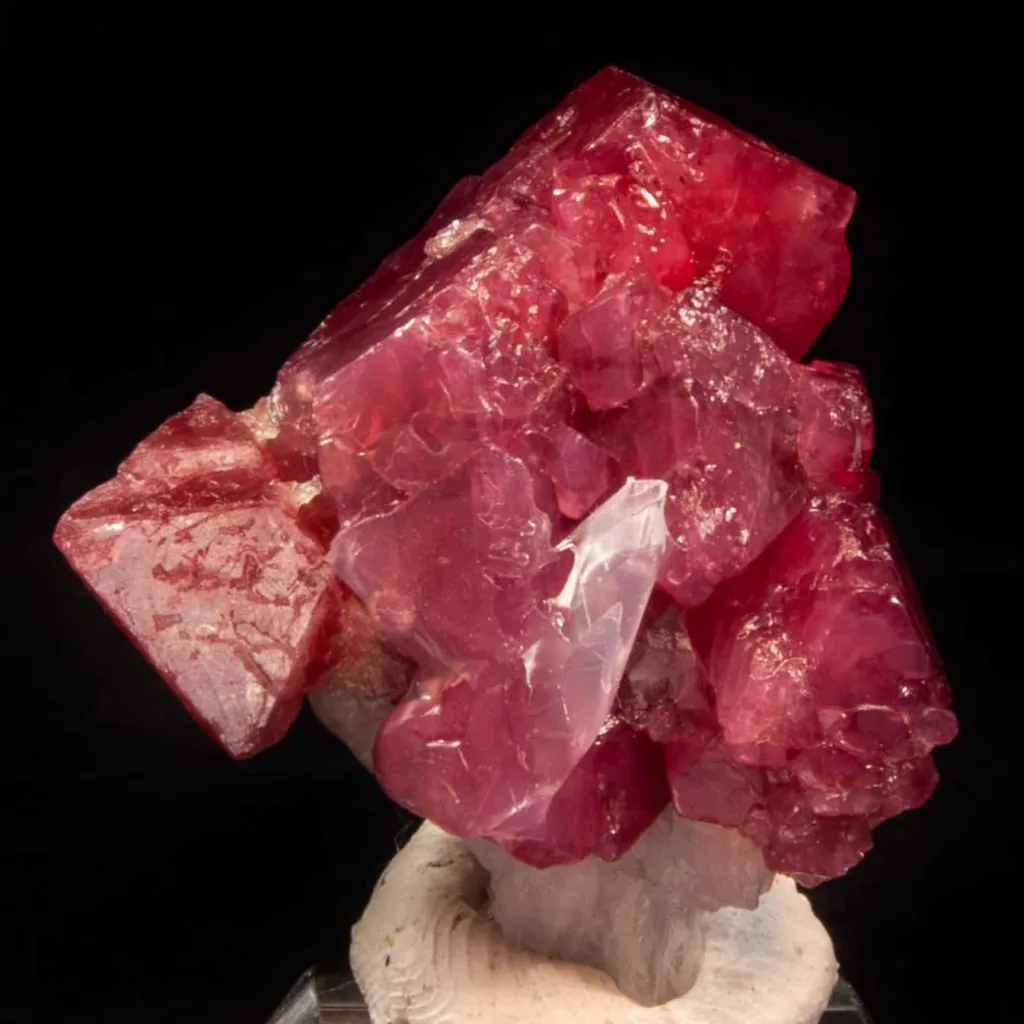
- Hardness: Spinel is relatively hard and has a hardness of 7.5 to 8 on the Mohs scale. This makes it durable enough for use in jewelry.
- Density: The density of spinel ranges from 3.5 to 4.1 g/cm³, depending on its composition and impurities.
- Color: Spinel exhibits a wide range of colors, including red, pink, orange, blue, purple, and black. These colors are due to the presence of various transition metal ions as impurities in the crystal lattice.
- Luster: Spinel has a vitreous to subadamantine luster, which means it has a glass-like or slightly greasy shine when polished.
- Transparency: Spinel is transparent to translucent, allowing light to pass through the gemstone to varying degrees.
Optical Properties
- Refractive Index: The refractive index of spinel varies depending on its composition and color. Generally, it falls between 1.712 and 1.736 for red to orange spinels and slightly higher for blue spinels.
- Dispersion: Spinel exhibits relatively low dispersion, which refers to the separation of white light into its spectral colors. This property is responsible for the “fire” seen in some gemstones.
- Birefringence: Spinel is an isotropic material, meaning it doesn’t exhibit birefringence. This characteristic sets it apart from anisotropic minerals that can split light into two rays.
- Pleochroism: Since spinel is isotropic, it doesn’t show pleochroism, which is the ability of a mineral to display different colors when viewed from different angles.
- Fluorescence: In some cases, spinel can exhibit fluorescence under ultraviolet (UV) light. The color and intensity of fluorescence can vary.
Overall, spinel’s optical properties contribute to its appeal as a gemstone, with its wide range of colors and luster making it a sought-after choice for jewelry and ornamental purposes.
Types and Colors of Spinel
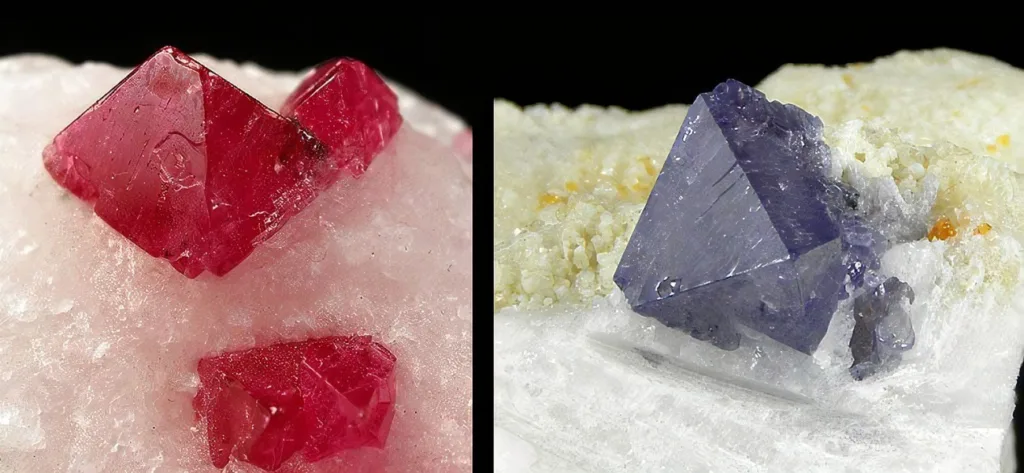
Spinel is known for its diverse range of colors, each of which is associated with specific trace elements present in the crystal structure. Here are some of the most prominent types and colors of spinel:
- Red Spinel: Red spinel is perhaps the most famous and historically significant color. It is often mistaken for ruby due to its vibrant red hue. The red color is caused by traces of chromium in the crystal lattice. Some famous red spinels have been misidentified as rubies, contributing to their historical importance.
- Pink Spinel: Pink spinel ranges from pale to intense pink shades. It is also caused by the presence of chromium, but in lower concentrations compared to red spinel. Pink spinels are highly valued for their delicate and romantic color.
- Orange Spinel: The orange color in spinel comes from a combination of iron and chromium. Orange spinels can vary from subtle apricot tones to deeper, more vibrant oranges.
- Blue Spinel: Blue spinel is a rare and prized variety. It gets its blue color from traces of cobalt within the crystal structure. The shades of blue can range from light to intense, and they are often reminiscent of sapphire’s blue.
- Purple Spinel: Purple spinel is caused by a mix of iron and trace elements such as chromium and zinc. It can display a range of purple shades, from soft lavender to rich violet.
- Black Spinel: Black spinel is a unique variety known for its deep black color. Despite its darkness, it often has a good luster and can be used as an alternative to other black gemstones like onyx.
- Colorless Spinel: Colorless spinel is highly transparent and lacks significant coloration. It is relatively rare and can be used as a diamond substitute in jewelry.
- Other Colors: Spinel can also occur in other less common colors, including yellow, green, and brown, although these colors are less frequently encountered compared to the ones mentioned above.
It’s important to note that the specific colors of spinel can sometimes overlap or exhibit variations depending on the concentration of trace elements and the overall chemical composition. The beauty and desirability of spinel are derived from this spectrum of colors, making it a versatile gemstone for various jewelry designs and preferences.
Formation and Occurrence
Spinel is formed through various geological processes, primarily as a result of metamorphism and magmatic activities. It can be found in different types of rock formations, such as marble, metamorphic rocks, and igneous rocks. The formation of spinel is influenced by the availability of its constituent elements, primarily magnesium and aluminum, along with trace elements that give rise to its diverse colors.
Geographical Sources:
Spinel is found in various locations around the world. Some of the notable sources include:
- Myanmar (Burma): Myanmar has been a historically significant source of high-quality spinel, including the famous “Mogok” region. This region is known for producing exceptional red and pink spinels.
- Sri Lanka: Sri Lanka has been a source of various gemstones, including spinel. It has yielded a range of colors, from pink and red to blue and purple.
- Tajikistan: The Pamir Mountains in Tajikistan are known for producing blue spinels, often referred to as “Badrak” spinels. These blue spinels can rival the richness of sapphire’s blue.
- Vietnam: Vietnam has become a notable source of spinel, especially for red and pink varieties. Some of its spinels are sought after for their intense colors.
- Madagascar: Madagascar is known for producing spinels in various colors, including red, pink, and blue. The Mahenge region, in particular, has gained attention for its vivid pink spinels.
- Tanzania: The Mahenge region in Tanzania has also become famous for its vibrant pink to reddish-orange spinels.
- Afghanistan: Afghanistan is known for producing various gemstones, including spinel in colors ranging from red and pink to purple and blue.
Geological Conditions:
Spinel forms under specific geological conditions, often in association with high-pressure and high-temperature environments. It can occur in metamorphic rocks like marble and schist, where intense heat and pressure cause minerals to recrystallize and form new compounds. Spinel can also be found in certain types of igneous rocks, such as basalt and kimberlite pipes, which are formed by volcanic activity and can carry gem-rich materials from deep within the Earth’s mantle.
Associations with Other Minerals:
Spinel can be found alongside various other minerals due to its occurrence in different types of rocks. Some minerals that can be associated with spinel include:
- Garnet: Spinel and garnet can sometimes be found together in metamorphic rocks. Both minerals have similar hardness and stability under heat and pressure.
- Corundum (Ruby and Sapphire): In some regions, spinel and corundum can occur together. In fact, historical confusion between red spinel and ruby led to some spinels being mistaken for rubies.
- Zircon: Zircon and spinel can coexist in certain types of igneous rocks, particularly in alluvial deposits where these minerals are eroded and transported by water.
- Quartz: Spinel can occasionally be found in association with quartz, especially in pegmatite veins and other geological formations.
The occurrence of spinel alongside these minerals depends on the specific geological processes and conditions of each region.
Uses of Spinel
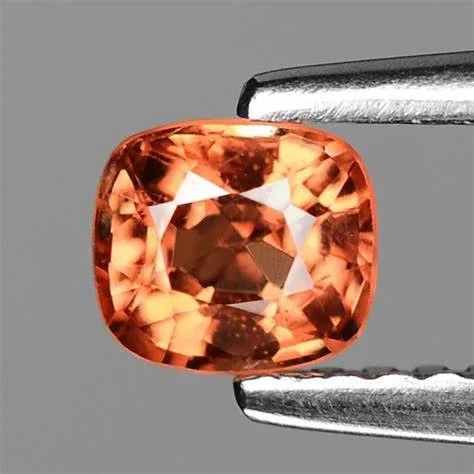
Spinel has a range of applications due to its aesthetic appeal, durability, and unique properties. Its uses span from jewelry and ornaments to industrial and technological applications.
Jewelry and Ornaments:
- Gemstone Jewelry: Spinel is highly valued as a gemstone for its vivid colors and durability. It is often used in various types of jewelry, including rings, necklaces, earrings, and bracelets. The most sought-after colors are red, pink, blue, and violet.
- Engagement Rings and Fine Jewelry: Spinel’s hardness and variety of colors make it suitable for engagement rings and other fine jewelry pieces. It offers an alternative to traditional gemstones like diamond, ruby, and sapphire.
- Collectible Gemstones: Rare and high-quality spinels, especially those with exceptional color and clarity, are sought after by gem collectors and enthusiasts.
Industrial Applications:
- Abrasive Material: Spinel’s hardness makes it suitable for use as an abrasive material in cutting and grinding tools. It can be used in manufacturing processes that require precision shaping of materials.
- Ceramics: Spinel is used in the production of advanced ceramics due to its thermal and chemical stability. It can be found in ceramic components for industries such as electronics and aerospace.
- Refractories: Spinel’s resistance to high temperatures and chemical corrosion makes it valuable in refractory applications. Refractories are materials used to line furnaces, kilns, and other high-temperature environments.
- Coatings and Pigments: Spinel can be used as a coating material for various surfaces, providing protection against wear, heat, and corrosion. Additionally, spinel pigments can be used in the production of colored paints and coatings.
Scientific and Technological Uses:
- Laser Crystals: Spinel can be used as a host material for certain types of lasers. It has gained attention in laser technology due to its ability to emit laser light at various wavelengths.
- Electronics: In recent years, spinel has been investigated for its potential use in electronics, particularly as a material for transparent conductive coatings, which have applications in displays and solar cells.
- Research and Experimentation: Spinel’s unique properties, such as its wide color range and resistance to high temperatures, make it valuable for scientific research, experimentation, and testing in various fields of study.
- Optics and Lenses: Some spinels, particularly those with high clarity and transparency, can be used in optical applications, including lenses, windows, and optical instruments.
Overall, spinel’s versatility in terms of color, hardness, and properties makes it valuable in a range of applications, from traditional gemstone jewelry to cutting-edge technological advancements.
Summary of Key Points
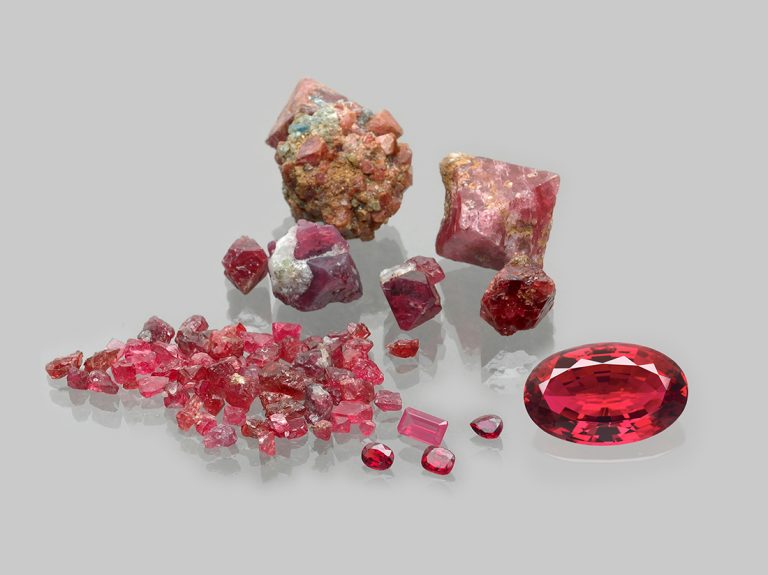
- Definition and Overview: Spinel is magnesium aluminum oxide (MgAl2O4) with a cubic crystal structure. Its various colors arise from trace elements in its composition, and its luster is vitreous to subadamantine.
- Historical Significance: Spinel has been historically mistaken for ruby, leading to gemological confusion. Notable instances include the “Black Prince’s Ruby” and “Timur Ruby.” It was cherished in ancient civilizations, with writings by Pliny the Elder mentioning spinel’s beauty.
- Types and Colors: Spinel comes in a spectrum of colors due to trace elements:
- Red spinel, resembling ruby, contains chromium.
- Pink spinel gets its hue from less chromium than red spinel.
- Orange spinel results from a blend of iron and chromium.
- Blue spinel’s cobalt content imparts its color.
- Purple spinel’s iron and trace elements create varying violet shades.
- Black spinel is a dark, lustrous variety.
- Other types include colorless, yellow, green, and brown spinels.
- Formation and Occurrence: Spinel forms via metamorphic and magmatic processes. It’s found in various rocks, such as marble and igneous formations. Geographical sources include Myanmar, Sri Lanka, Tajikistan, Vietnam, Madagascar, Tanzania, and Afghanistan.
- Geological Conditions: Spinel forms under high pressure and temperature conditions in metamorphic rocks and igneous formations.
- Associations with Other Minerals: Spinel can occur alongside garnet, corundum, zircon, and quartz due to geological processes.
- Uses:
- Jewelry and Ornaments: Spinel is used in gemstone jewelry, engagement rings, and collectible pieces for its durability and vibrant colors.
- Industrial Applications: Its hardness lends itself to abrasives, ceramics, refractories, coatings, and pigments.
- Scientific and Technological Uses: Spinel finds applications in laser crystals, electronics, research, experimentation, optics, and lenses.
Spinel’s beauty, historical significance, and versatile properties have led to its popularity in various fields, from the world of gemstones and jewelry to cutting-edge scientific and industrial applications.




































